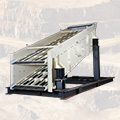A GUIDE TO VIBRATING SCREEN AND FEEDERS
September 24, 2014
Assemblies of feeders and screens wrap several purposes into one long package. The machinery, when seen as a whole, uses reciprocating motors to convey raw material from one stage of a manufacturing process to the next. Powerful electric or diesel motors work out of phase alongside coiled springs made of high-tensile steel to generate momentum, directing particulate matter along the vibrating rubber or polyurethane screens. Abrasion is minimized by these durable screens, and the generation of synchronous motion advances the dry or wet material while the grid structure of the screen acts as a separator.
The separation dynamic employs a single or double layered arrangement of screens to sort and grade material. This screening or grading action is an integral part of a high-efficiency feeder and screen system. It’s used in coal mines, grading the fossil fuel, and in quarries to categorize rock, granite, ore and minerals. The screen media is the component in the sequence that separates the flow of material, filtering slurry and rocky loads alike. Coarse and fine matter is removed and deposited at lower collection points. Inclined mechanisms use gravitational force to aid in the movement while horizontal configurations depend on a series of motors to keep the motion cycling all day long.
Transport and classification is the backbone of vibrating screen and feeder operation. The technology is installed in mines, quarries, and other heavy industries, but the principle also works to remove water, dewatering slurry to leave dry matter that can be stockpiled or sent to another stage in the process. Linear vibrating screens are most recognized in the industry, but circular designs are available. Maintenance and real-world applications are accounted for by easy to swap out parts in the feeder assemblies, meaning screens can be replaced if they wear or switched for a screen sporting a different mesh size.
Vibratory feeders deliver low-frequency oscillations to enable material of any shape, size, or consistency to move across sorting mesh and grading plastics punctuated with precisely sized openings. Bulk movement through linear reciprocating motion, the apparatus is durable and reliable, quick to sort and handle the finest sand and the coarsest rocks. Production environments employ the same system, conveying and sorting everything from grain to powdered pharmaceuticals. There’s even a precedent for using vibrating screens in active settings, not just transporting coal but supplying the coal as a fuel directly to a furnace or a power turbine.
Screening Technology Pty Ltd T/AS Hawk Machinery
Address: 7 Lantana St Blackburn North Vic 3130
Contact Person: Bohdan Blaszczyk
Phone: +61 3 9877 7777
Fax: +61 3 9877 8177
Mobile: 0411 099 989
Email: info@hawkmachinery.com.au
Optimized by NetwizardSEO.com.au
Optimized by: Netwizard SEO
